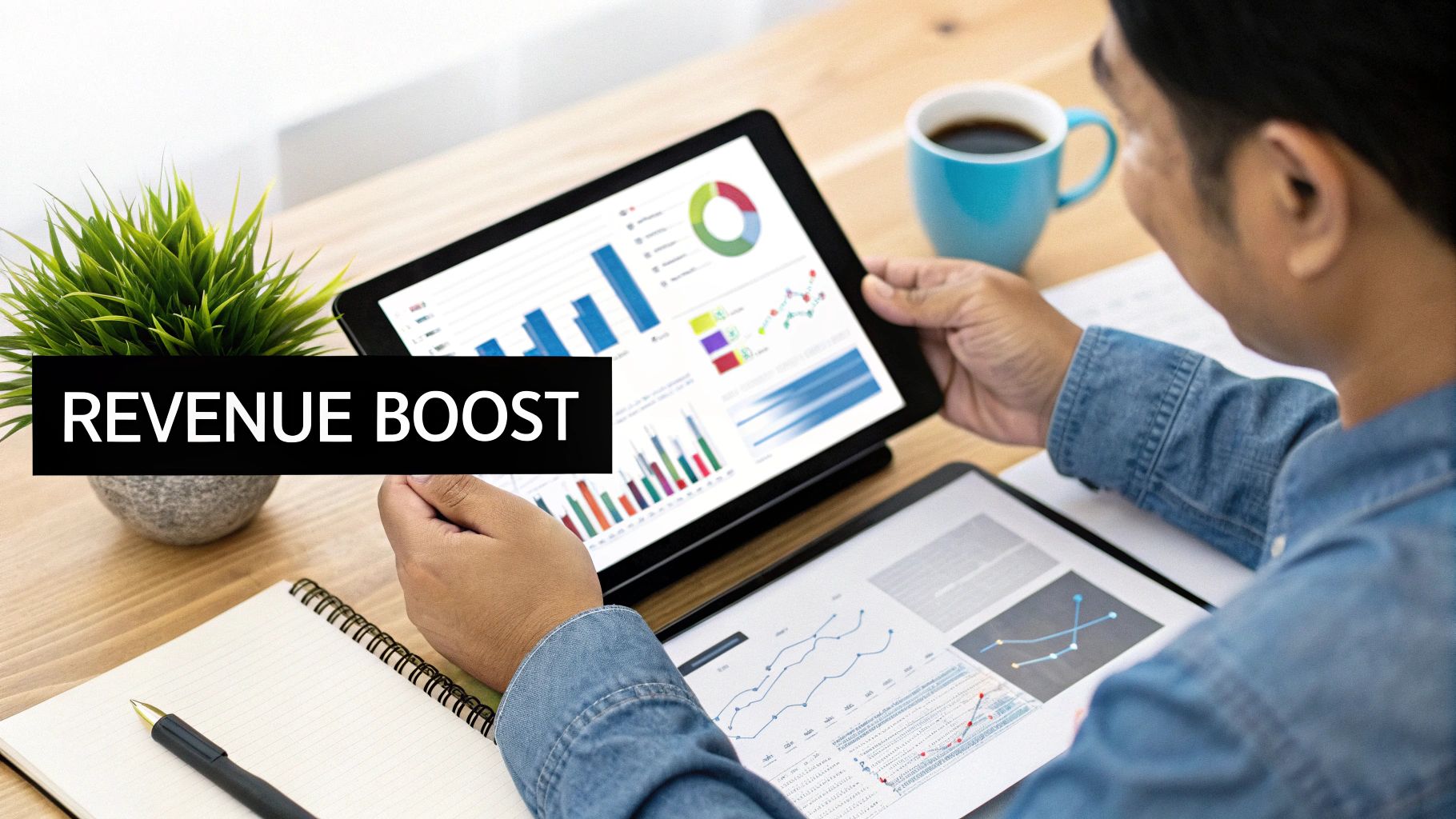Mastering The Fundamentals Of Profitability Analysis

Profitability analysis is about more than just your bottom line. It's about understanding what drives your profits. It involves examining your financials to identify what's working, what's not, and where the greatest opportunities for growth exist.
This in-depth analysis reveals your true financial health and can uncover hidden potential often missed by competitors. For example, two businesses might have identical revenue figures, but vastly different profit margins. This difference can be due to variations in their cost structures.
Profitability analysis helps pinpoint these variations, providing insights needed to optimize performance. Understanding profitability means understanding not just if you are making money, but how you are making money.
Key Profitability Metrics
Several key metrics are essential for a thorough profitability analysis. These metrics provide a comprehensive overview of your financial performance.
-
Gross Profit Margin: This metric measures the profitability of your sales after deducting the direct costs of production. A higher gross profit margin suggests efficient production and pricing strategies.
-
Net Profit Margin: This metric reveals the percentage of revenue left after all expenses have been paid. This includes taxes and interest. It represents the overall profitability of your business.
-
Return on Assets (ROA): ROA indicates how effectively your company uses its assets to generate profit. A higher ROA signifies better asset utilization.
-
Return on Equity (ROE): ROE measures the return generated on shareholder investments. A strong ROE attracts investors and indicates efficient use of capital.
Understanding Profitability Across Different Business Landscapes
The business landscape is diverse. Consider Small and Medium Enterprises (SMEs) in the UK. As of October 2023, there were approximately 5.6 million registered SMEs, contributing significantly to the UK economy.
The median profit for SMEs in 2022 was around £12,000. However, this figure varied across different sectors. For instance, property and business services SMEs averaged higher profits, around £15,000. SMEs in health and social work averaged £7,000. These figures demonstrate how industry dynamics impact profitability. Discover more insights about UK SME statistics
Common Profitability Metrics & Their Uses
Understanding the practical uses of profitability metrics is crucial for effective decision-making. The following table provides a clear breakdown:
To help clarify these metrics, let's look at the following table.
| Metric | Formula | What It Tells You | Best For |
|---|---|---|---|
| Gross Profit Margin | (Revenue – Cost of Goods Sold) / Revenue | Efficiency of production and pricing | Evaluating product pricing and production costs |
| Net Profit Margin | (Net Profit / Revenue) * 100 | Overall profitability after all expenses | Assessing overall business health and financial performance |
| Return on Assets (ROA) | (Net Income / Total Assets) * 100 | How well assets generate profit | Evaluating asset utilization and operational efficiency |
| Return on Equity (ROE) | (Net Income / Shareholder Equity) * 100 | How well shareholder investments generate returns | Assessing investment returns and capital management |
This table summarizes the key profitability metrics, their formulas, and their practical applications for business analysis. By analyzing these metrics within the context of your specific business, you can identify areas for improvement. This can lead to informed decisions that drive sustainable growth and long-term financial success.
Real-World Profitability Analysis Example Breakdown
Let's shift our focus from theoretical concepts to practical application with a real-world profitability analysis example. Consider "Fashion Forward," a hypothetical online clothing retailer. They're looking to move beyond simple revenue figures and gain a more comprehensive understanding of their profitability. This is where a profitability analysis comes into play.
Analyzing Fashion Forward's Financials
Fashion Forward's income statement shows £500,000 in revenue. The cost of goods sold (COGS), encompassing manufacturing and shipping, amounts to £200,000. This results in a gross profit of £300,000. Operating expenses, including marketing and salaries, reach £150,000, leaving an operating profit of £150,000. After accounting for taxes and interest, Fashion Forward's net profit stands at £100,000.
This initial analysis offers a basic overview of Fashion Forward's profitability. However, a more detailed examination is needed to uncover potential opportunities for improvement.
Considering External Factors
Understanding the impact of broader economic trends is a key component of any financial analysis. Recent data on UK economic performance reveals fluctuations in profitability across different sectors. In Q2 2024, the net rate of return for private non-financial corporations in the UK was 8.8%, a slight decrease from 9.0% in Q1 2024. This dip was primarily driven by a reduction in net operating surplus. Conversely, the services sector experienced a profitability increase, reaching 15.1%. Explore this data further.
This macroeconomic context is valuable when assessing Fashion Forward's performance.
Calculating Key Profitability Metrics
With this broader context in mind, calculating key profitability metrics for Fashion Forward is the next step. Their gross profit margin, calculated by dividing gross profit by revenue (£300,000/ £500,000), is 60%. This suggests a healthy profit on each sale. Their net profit margin, calculated by dividing net profit by revenue (£100,000/ £500,000), is 20%. This reflects the overall profitability after all expenses are considered.
For further analysis, let's assume Fashion Forward has £400,000 in total assets and £250,000 in shareholder equity. This allows us to calculate Return on Assets (ROA) and Return on Equity (ROE). Their ROA (£100,000/ £400,000) is 25%, indicating efficient asset utilization. Their ROE (£100,000/ £250,000) is 40%, signaling a strong return for investors.
Identifying Areas for Improvement
Analyzing these metrics reveals valuable insights for Fashion Forward. While their overall profitability appears healthy, comparing these figures against industry benchmarks and competitors would provide a more complete picture. This might involve examining product-specific profitability, customer segmentation, or operational efficiency to pinpoint specific areas for potential improvement. This deeper dive can provide Fashion Forward with actionable insights to drive future growth and optimize financial performance.
Industry-Specific Profitability Analysis Approaches

Applying generic metrics across all industries is a common mistake in profitability analysis, often leading to inaccurate conclusions. Profitability analysis frameworks should be designed with the specific characteristics of each industry in mind. A manufacturing business, for instance, assesses profitability differently than a service-based business.
Manufacturing: Contribution Margin Analysis
Contribution margin analysis is essential in manufacturing. This involves deducting variable production costs directly from revenue. The remaining amount helps determine the profitability of individual products and product lines. This process differs greatly from the analysis of a service business. Manufacturers calculate direct material and labor costs per unit, a core component of their contribution margin calculation.
Retail: Inventory Performance and Profitability
Retail businesses must carefully evaluate inventory performance against profitability. Excess inventory ties up capital and increases storage costs, impacting profitability. Effective inventory management is therefore critical. Analyzing inventory turnover, for example, reveals how quickly stock sells. This metric directly influences pricing and purchasing decisions, which in turn affects profitability.
Service Businesses: Cost of Service and Pricing Strategy
Service businesses place a high value on understanding their cost of service. This understanding allows for strategic pricing. Accurate cost allocation, often involving tracking labor hours and associated costs for each service, is critical. This data is essential for developing pricing and profitability strategies.
Digital Businesses: Customer Acquisition Cost and Lifetime Value
Digital businesses focus heavily on customer acquisition cost (CAC) and customer lifetime value (CLV). Maintaining a balance between these two metrics is essential. A high CAC can be worthwhile if the CLV is equally high, indicating strong, long-term customer relationships. A Software as a Service (SaaS) business, for instance, might invest significantly in marketing to acquire customers. The long-term revenue generated by these customers determines the profitability of this strategy.
Benchmarking and Contextualizing Performance
Benchmarking against competitors within your specific sector—rather than relying on broad industry averages—is vital. This approach puts your performance into context. Also, external factors like changes in monetary policy can dramatically affect profitability. For example, the rising base rate in the UK financial sector since December 2021 significantly impacted profitability. Reaching 5.25% by August 2023, this rise increased net interest margins (NIMs). Savings NIMs grew from 0.58% in October 2021 to 1.78% by March 2023, then slightly declined to 1.56% by September 2023. The Financial Conduct Authority (FCA) provides more detailed statistics, highlighting how external economic factors influence profitability. Find more detailed statistics here.
To further illustrate the importance of industry-specific analysis, let's consider the following table:
Industry Profitability Comparison: Comparison of profitability metrics and analysis approaches across different industry sectors
| Industry | Key Profitability Metrics | Typical Margins | Analysis Focus |
|---|---|---|---|
| Manufacturing | Contribution Margin, Gross Profit Margin | 5% – 20% | Cost control, production efficiency, pricing optimization |
| Retail | Gross Margin, Inventory Turnover, Sales per Square Foot | 2% – 10% | Inventory management, pricing strategy, sales performance |
| Service | Revenue per Employee, Utilization Rate, Project Profitability | 10% – 50% | Cost of service, pricing strategy, resource allocation |
| Digital | Customer Acquisition Cost (CAC), Customer Lifetime Value (CLV), Churn Rate | Highly variable | Customer acquisition & retention, pricing models, subscription management |
This table summarizes key profitability metrics and areas of focus for various sectors. As shown, the metrics and analysis methods vary considerably across industries. This reinforces the need for a tailored approach to profitability analysis.
Ultimately, tailoring your analysis to your industry’s specific characteristics ensures you gain the most relevant insights for your business.
Advanced Techniques That Reveal Hidden Profitability

Basic profitability metrics are essential, but they only scratch the surface. To truly understand your business performance, you need to delve deeper. Several advanced techniques can uncover hidden pockets of profit and loss, providing a granular view of your operations. This detailed understanding is a practical example of profitability analysis in action.
Customer Profitability Segmentation
Customer profitability segmentation groups your customers based on their individual profitability. This helps identify your most valuable customers and those who might be costing you more than they bring in.
For instance, a small group of customers might be responsible for a surprisingly large portion of your profits. On the other hand, some customers could require extensive resources and support, reducing their overall profitability. This information is vital for effective resource allocation and targeted marketing.
Product Line Profitability Analysis
Product line profitability analysis assesses the profitability of each product or service you offer. This process pinpoints high-performing products and those that might need a second look, or even discontinuation. The analysis factors in both direct and indirect costs for each product line.
A high-volume product could have surprisingly low-profit margins due to high production costs. Conversely, a lower-volume product might boast higher margins. These insights are key for informed decisions about product development, pricing, and marketing strategies.
Activity-Based Costing
Activity-based costing (ABC) offers a more accurate view of your costs by linking them to specific activities. Traditional costing methods often allocate overhead costs based on factors like direct labor hours. ABC, however, assigns costs based on the activities that actually generate them.
This method can expose hidden cost drivers and refine the precision of your profitability analysis. For example, ABC might uncover that a specific product demands a disproportionate share of customer support, affecting its overall profitability. This detailed insight allows for targeted cost reductions and operational enhancements.
Multi-Period Trend Analysis
Multi-period trend analysis compares profitability metrics over multiple timeframes, such as quarters or years. This helps reveal developing trends and potential problems before they significantly impact your bottom line.
Tracking metrics over time reveals seasonal variations, growth patterns, or declining profitability in specific areas. This analysis is essential for proactive financial management and anticipating future difficulties and opportunities. Consistently declining profit margins for a particular product, for instance, could indicate a need for intervention, whether it's adjusting pricing strategies or streamlining production processes.
By combining these advanced techniques, businesses gain a more comprehensive understanding of their profitability drivers. They can then make data-driven decisions to optimize their performance. Mergoio, with its detailed profit tracking features, is a tool that empowers TikTok Shop and future Amazon sellers to conduct these analyses efficiently. Using such a tool can unlock insights that basic metrics might miss, leading to more strategic business decisions.
Avoiding Critical Profitability Analysis Mistakes
Even seasoned financial professionals can sometimes make common mistakes in profitability analysis. These errors can skew results, hindering informed decision-making and potentially impacting your business's bottom line. Let's explore some of the most common pitfalls and how to avoid them. This examination provides a practical example of how to conduct a robust profitability analysis.
Overlooking Indirect Costs
One of the most frequent mistakes is overlooking indirect costs. These are expenses not directly tied to production but essential for operations, such as administrative overhead, marketing, and rent. For example, a business analyzing the profitability of a single product might only consider the direct material and labor costs. The product might appear highly profitable based on these direct costs alone. However, including a share of indirect costs, like a marketing campaign specifically for that product, could reveal a significantly lower margin. This oversight can create a falsely optimistic view of profitability, leading to poor pricing and production decisions.
Misallocating Overhead Expenses
Overhead expenses, like utilities and rent, need to be accurately allocated to different products, departments, or projects. Incorrect allocation can distort the true profitability of individual segments. If overhead is distributed evenly across all product lines, a low-volume, high-margin product might appear less profitable than it actually is, while a high-volume, low-margin product could seem deceptively profitable. This can result in misallocation of resources, potentially focusing on less profitable areas.
Ignoring the Time Value of Money
For long-term investments, ignoring the time value of money is a crucial error. Money available today is worth more than the same amount in the future because of its potential earning capacity. Failing to account for this can lead to inaccurate profitability calculations for long-term projects. For example, comparing the initial investment in new equipment to the projected revenue over several years without discounting future cash flows will not provide a realistic assessment of the investment's true profitability. A proper discounted cash flow (DCF) analysis is crucial in these scenarios.
Safeguarding Your Analysis: Practical Tips
These pitfalls are avoidable with proactive measures. Implement these safeguards for accurate and insightful profitability analysis:
- Thorough Cost Accounting: Implement a detailed cost accounting system that captures both direct and indirect costs. This helps avoid overlooking hidden expenses and provides a complete financial picture.
- Regular Cost Audits: Conduct periodic audits of your cost accounting practices to ensure accuracy and identify misallocated expenses. Regular review can catch errors early on.
- Activity-Based Costing: Consider using activity-based costing (ABC). This method allocates overhead based on the activities driving those costs, providing a more accurate picture of cost drivers and offering more precise insights.
- Discounted Cash Flow Analysis: For long-term projects, use discounted cash flow (DCF) analysis to properly account for the time value of money. This will offer a more realistic profitability projection.
- Verification Framework: Develop a verification framework to double-check your analysis. This could involve comparing results against industry benchmarks or conducting peer reviews with colleagues. Independent validation helps identify potential errors and biases.
By avoiding these common mistakes and implementing the suggested safeguards, businesses can ensure their profitability analysis delivers accurate, actionable insights. These insights will lead to better decision-making and contribute to long-term financial health. Tools like Mergoio can be helpful for detailed tracking and analysis, providing specific data for accurate assessments and strategic planning. This allows businesses to move beyond basic calculations and utilize data-driven insights to achieve sustainable growth.
Essential Tools for Streamlined Profitability Analysis

The right tools can significantly improve your profitability analysis. They offer valuable insights while saving you time and resources. A range of solutions, from simple spreadsheet templates to advanced financial modeling platforms, caters to different needs and budgets. Choosing the right tool is crucial for effective analysis.
Spreadsheet Software: A Foundational Tool
Spreadsheet software like Microsoft Excel or Google Sheets offers an accessible starting point. These tools provide basic functionality for calculations and data organization. They are suitable for smaller businesses or preliminary analyses. However, they may lack the advanced features required for more complex situations. For example, a basic spreadsheet can calculate gross profit margins, but you might need more sophisticated software for in-depth customer profitability segmentation.
Financial Modeling Software: Enhanced Capabilities
For more complex analyses, dedicated financial modeling software offers advanced features. These tools often include pre-built templates for various analyses, such as discounted cash flow (DCF) and sensitivity analysis. They can handle larger datasets and automate complex calculations. However, they typically come with a higher cost.
Business Intelligence (BI) Platforms: Data-Driven Insights
Business intelligence (BI) platforms offer a broader view of business performance by integrating data from various sources. These platforms help visualize trends, identify key performance indicators (KPIs), and track progress toward goals. They are especially useful for companies with large datasets or those seeking a holistic operational view. However, BI platforms can be complex to implement and may require specialized expertise.
Dedicated Profitability Analysis Tools: Specialized Solutions
Some tools are specifically designed to streamline profitability analysis. They offer targeted features like automated reporting, real-time data updates, and industry-specific benchmarks. These tools can be particularly useful for businesses in specific sectors, such as e-commerce or manufacturing.
Choosing the Right Tool: Key Considerations
Selecting the right tool depends on several factors. These include your business size, the complexity of your analysis, and your budget. A small business might find spreadsheet software sufficient, while a larger enterprise might require a BI platform. Regardless of your choice, ensure the tool aligns with your specific needs and capabilities. This includes compatibility with existing systems and your team’s skillset. Consider the vendor's support level and the tool's scalability for future growth.
For TikTok Shop and future Amazon sellers needing detailed, real-time profitability insights, consider Mergoio. This platform offers comprehensive profit tracking, forecasting, and analysis capabilities specifically for e-commerce businesses. This makes it ideal for optimizing operational efficiency and boosting profitability.

Leave a Reply